
Hoysala architecture is the building style in Hindu temple architecture developed under the rule of the Hoysala Empire between the 11th and 14th centuries, in the region known today as Karnataka, a state of India. Hoysala influence was at its peak in the 13th century, when it dominated the Southern Deccan Plateau region. Large and small temples built during this era remain as examples of the Hoysala architectural style, including the Chennakesava Temple at Belur, the Hoysaleswara Temple at Halebidu, and the Kesava Temple at Somanathapura. Other examples of Hoysala craftsmanship are the temples at Belavadi, Amruthapura, Hosaholalu, Mosale, Arasikere, Basaralu, Kikkeri and Nuggehalli. Study of the Hoysala architectural style has revealed a negligible Indo-Aryan influence while the impact of Southern Indian style is more distinct.

The Chennakesava Temple, also referred to as Chennakeshava Temple and Keshava Temple, is a Vaishnava Hindu temple on the banks of River Kaveri at Somanathapura, Karnataka, India. The temple was consecrated in 1258 CE by Somanatha Dandanayaka, a general of the Hoysala King Narasimha III. It is located 38 kilometres (24 mi) east of Mysuru city.

Aihole, also referred to as Aivalli, Ahivolal or Aryapura, is a historic site of ancient and medieval era Buddhist, Hindu and Jain monuments in Karnataka, India that dates from the sixth century through the twelfth century CE. Most of the surviving monuments at the site date from the 7th to 10th centuries. Located around an eponymous small village surrounded by farmlands and sandstone hills, Aihole is a major archaeological site featuring over one hundred and twenty stone and cave temples spread along the Malaprabha river valley, in Bagalakote district.Hunagunda Taluk Distance 35km

Sri Varaha Lakshmi Narasimha temple, Simhachalam is a Hindu temple situated on the Simhachalam Hill Range, which is 300 metres above the sea level in Visakhapatnam, Andhra Pradesh, India. It is dedicated to Vishnu, who is worshipped there as Varaha Narasimha. As per the temple's legend, Vishnu manifested in this form after saving his devotee Prahlada from a murder attempt by the latter's father Hiranyakashipu. Except on Akshaya Trutiya, the idol of Varaha Narasimha is covered with sandalwood paste throughout the year, which makes it resemble a linga.
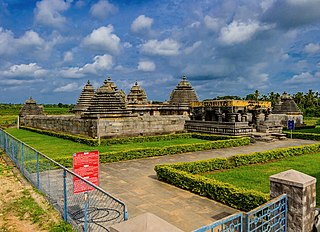
The Lakshmi Devi temple is an early 12th-century Hindu temples complex located in Doddagaddavalli village in Hassan District, Karnataka India. The main temple consists of four-shrines that share a common mandapa (hall), each sanctum being a square and aligned to a cardinal direction. The eastern shrine has Goddess Lakshmi, the northern shrine is dedicated to Kali-Durga, the western to Shiva, and the southern is empty and likely Vishnu. The complex has a separate Bhairava shrine to the northeast of the main temple, and four small shrines at the corners inside a nearly square prakara (compound). All nine temples are notable for its pyramidal north Indian style Nagara shikhara – likely an influence from Maharashtra and an evidence of active flow of ideas between the southern, central and northern India. The complex has additional smaller shrines.

The Sun Temple is a Hindu temple dedicated to the solar deity Surya located at Modhera village of Mehsana district, Gujarat, India. It is situated on the bank of the river Pushpavati. It was built after 1026-27 CE during the reign of Bhima I of the Chaulukya dynasty. No worship is offered now and is protected monument maintained by Archaeological Survey of India. The temple complex has three components: Gudhamandapa, the shrine hall; Sabhamandapa, the assembly hall and Kunda, the reservoir. The halls have intricately carved exterior and pillars. The reservoir has steps to reach the bottom and numerous small shrines.

The Lakshmi Narasimha temple was built in 1246 CE by Bommanna Dandanayaka, a commander in the Hoysala Empire during the rule of King Vira Someshwara. It is a good example of 13th-century Hoysala architecture. Located a short distance away in Nuggehalli, and built around the same time is the Sadashiva temple. The town was called Vijaya Somanathapura in ancient times and gained importance as an agrahara during the time of Bommanna Dandanayaka. Nuggehalli,, is a town in Hassan district of Karnataka, India. It is located on the Tiptur-Channarayapatna state highway and is about 50 km from Hassan city. It is well connected by road with Bangalore, the state capital.

The Badami cave temples are a complex of Hindu and Jain cave temples located in Badami, a town in the Bagalkot district in northern part of Karnataka, India. The caves are important examples of Indian rock-cut architecture, especially Badami Chalukya architecture, and the earliest date from the 6th century. Badami is a modern name and was previously known as Vataapinagara, the capital of the early Chalukya dynasty, which ruled much of Karnataka from the 6th to the 8th century. Badami is situated on the west bank of a man-made lake ringed by an earthen wall with stone steps; it is surrounded on the north and south by forts built in later times.

Chennakeshava Temple, also referred to as Keshava, Kesava or Vijayanarayana Temple of Belur, is a 12th-century Hindu temple in the Hassan district of Karnataka state, India. It was commissioned by King Vishnuvardhana in 1117 CE, on the banks of the Yagachi River in Belur also called Velapura, an early Hoysala Empire capital. The temple was built over three generations and took 103 years to finish. It was repeatedly damaged and plundered during wars, repeatedly rebuilt and repaired over its history. It is 35 km from Hassan city and about 200 km from Bengaluru.
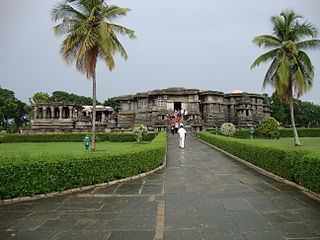
Hoysaleswara temple, also referred simply as the Halebidu temple, is a 12th-century Hindu temple dedicated to Shiva. It is the largest monument in Halebidu, a town in the state of Karnataka, India and the former capital of the Hoysala Empire. The temple was built on the banks of a large man-made lake, and sponsored by King Vishnuvardhana of the Hoysala Empire. Its construction started around 1121 CE and was complete in 1160 CE. During the early 14th century, Halebidu was twice sacked and plundered by the Muslim armies of the Delhi Sultanate from northern India, and the temple and the capital fell into a state of ruin and neglect. It is 30 kilometres (19 mi) from Hassan city and about 210 kilometres (130 mi) from Bengaluru.
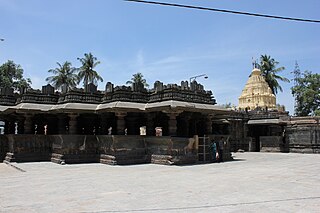
The Harihareshwara Temple at Harihar in Karnataka state, India, was built in c. 1223–1224 CE by Polalva, a commander and minister of the Hoysala Empire King Vira Narasimha II. In 1268 CE, Soma, a commander of King Narasimha III of the same dynasty made some additions. The temple houses the deity Harihara, a fusion of the Hindu Gods Mohini and Shiva. The image of the deity is a fusion of the right vertical half of Shiva and left vertical half of Female Vishnu. The image holds in its right hand, the attributes of Shiva and in the left hand, those of Vishnu.

Hanuman Dhoka is a complex of structures with the Royal Palace of the Malla kings and also of the Shah dynasty in the Durbar Square of central Kathmandu, Nepal. It is spread over five acres. The Hanuman Dhoka Palace gets its name from the stone image of Hanuman, the Hindu deity, that sits near the main entryway. 'Dhoka' means door or gate in Nepali. The buildings were severely damaged in the 2015 earthquake.
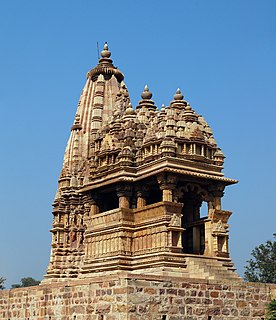
The Javari Temple in Khajuraho, India, is a Hindu temple, which forms part of the Khajuraho Group of Monuments, a UNESCO World Heritage Site. It was built between c. 975 and 1100 A.D.
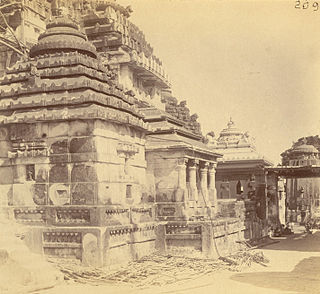
The Vimala Temple or Bimala Temple is a Hindu temple dedicated to goddess Vimala (Bimala), located within the Jagannath Temple complex in Puri in the Indian state of Odisha. It is generally regarded as a Shakti Pitha, among the holiest temples dedicated to the Hindu Goddess.
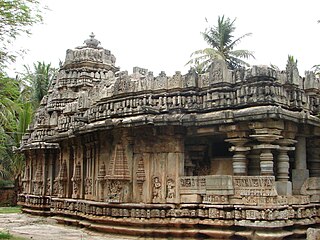
The Brahmeshvara temple, also referred to as the Brahmeshwara or Brahmesvara temple, is a 12th-century Hindu temple with Hoysala architecture in Kikkeri village, Mandya district of Karnataka state, India. Along with two other major historic temples within the village, the Brahmeshvara temple is one of many major ruined temples with notable artwork in Kikkeri area close to the more famous monuments of Shravanabelagola.
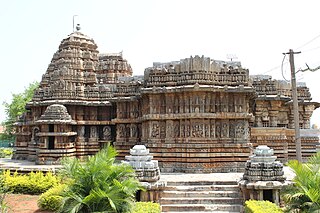
The Lakshminarasimha temple at Haranhalli, sometimes referred to as Lakshmi Narasimha temple of Haranhalli, is one of two major historic Hindu temples that have survived in Haranhalli, Karnataka, India. It is triple-shrine temple dedicated to Vishnu, while the other – Someshvara Temple, Haranhalli few hundred meters to the east – is dedicated to Shiva. Both temples reflect a Vesara-style Hoysala architecture, share similar design ideas and features, and were completed in the 1230s by three wealthy brothers – Peddanna Heggade, Sovanna and Kesanna.

Ijo temple is a Hindu candi (temple) located 4 kilometers from Ratu Boko or around 18 kilometers east from Yogyakarta, Indonesia. The temple was built between 10th to 11th century CE during the Mataram Kingdom period.

The Lakshana Devi Temple in Bharmour is a post-Gupta era Hindu temple in Himachal Pradesh dedicated to Durga in her Mahishasura-mardini form. It is dated to the second half of the 7th-century, and is in part one of the oldest surviving wooden temples in India.

Iswara temple also known by other names Kamalishwara temple, Kamaleshwara temple, Kalleshwara temple, Eshwara temple is located in Jalasangvi village, about 10 km north-west of Humnabad Taluk of Bidar district, Karnataka, India. According to the inscriptions found the temple was built during the reign of the celebrated emperor Vikramaditya VI of Kalyana Chalukya dynasty.

Badut is an 8th-century Hindu candi (temple) located in Tidar area around 5 kilometres west from the center of Malang city. This andesite stone structure is located in Karang Besuki village, Dau subdistrict, Malang Regency, East Java Indonesia.
































